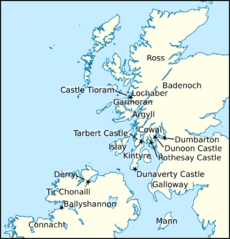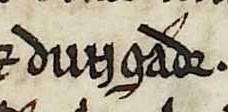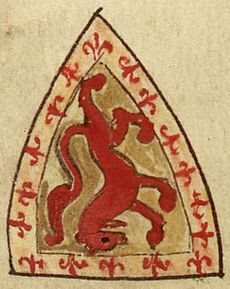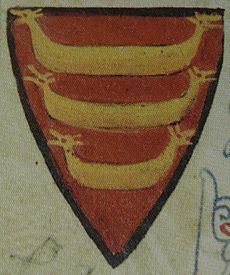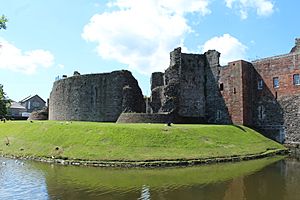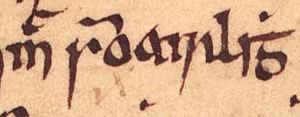Ruaidhrí mac Raghnaill facts for kids
Quick facts for kids
Ruaidhrí mac Raghnaill
|
|
|---|---|
| Lord of Kintyre | |

Ruaidhrí's name from an old book, the Annals of Ulster.
|
|
| Died | 1247? |
| Noble family | Clann Somhairle |
| Issue | Dubhghall, Ailéan, and possibly two daughters |
| Father | Raghnall mac Somhairle |
Ruaidhrí mac Raghnaill (died around 1247) was an important leader in the Kingdom of the Isles. He was part of a powerful family called Clann Somhairle. Ruaidhrí was the son of Raghnall mac Somhairle, and his family branch became known as Clann Ruaidhrí.
After a big battle in 1210, Ruaidhrí might have become the main leader of Clann Somhairle. Around this time, he seemed to arrange a marriage alliance with the ruler of the Isles, Rǫgnvaldr Guðrøðarson, King of the Isles. This helped bring the Kingdom of the Isles back together under Clann Somhairle and the Crovan family.
In the early 1200s, the Scottish King faced rebellions from a royal family branch called the Meic Uilleim. Ruaidhrí is recorded fighting alongside Thomas fitz Roland, Earl of Atholl against people in Ireland. These sea attacks might have been to stop Irish groups who supported the Scottish rebels.
In 1221 or 1222, Alexander II, King of Scotland led attacks into Argyll. This pushed Scottish royal power into Kintyre. It seems Ruaidhrí was forced out of Kintyre and his younger brother, Domhnall, took his place. The exact reasons for Alexander's attack are not fully clear. It might have been because a united Kingdom of the Isles seemed like a threat. Or, if Ruaidhrí had supported the Scottish rebels, the King might have been punishing him.
Some old stories say a man named Roderick joined the last Meic Uilleim rebellion against King Alexander. It's possible this Roderick was Ruaidhrí. If so, Ruaidhrí might have joined the rebels after being kicked out of Kintyre by the Scottish King. While Ruaidhrí's family later ruled parts of the Hebrides, we don't know exactly when they got these lands.
In 1230, after Scotland got involved in the Isles, Hákon Hákonarson, King of Norway sent Óspakr-Hákon to take control as King of the Isles. Ruaidhrí is not mentioned in this Norwegian campaign. This could mean he was busy helping the Meic Uilleim rebellion, or that he didn't like the idea of Óspakr-Hákon being his overlord.
Ruaidhrí might be the same "Mac Somhairle" who died in a battle in 1247. He was helping Maol Seachlainn Ó Domhnaill, King of Tír Chonaill fight an English invasion. The next year, Ruaidhrí's son, Dubhghall, and another Clann Somhairle leader asked King Hákon to be King of the Isles. It's thought that Mac Somhairle had been recognized as King of the Isles by Hákon before he died. Ruaidhrí's sons were definitely active in Ireland later. His younger son, Ailéan, was one of the first known gallowglass commanders. Gallowglasses were a type of warrior.
Contents
Ruaidhrí's Family History
Ruaidhrí was likely the oldest son of Raghnall mac Somhairle. Raghnall was the son of Somhairle mac Giolla Brighde, King of the Isles. Somhairle was the ancestor of all of Clann Somhairle.
Another son of Somhairle was Dubhghall, who started the Clann Dubhghaill family. Ruaidhrí started the Clann Ruaidhrí family, and his brother, Domhnall, started the Clann Domhnaill family.
It's not completely clear who led Clann Somhairle after Somhairle died in 1164. Some old records say Dubhghall was the main leader. But later, Raghnall was called "king of the Isles, lord of Argyll and Kintyre." This might mean he took control of the Clann Somhairle lands. We don't know exactly when or how Raghnall died.
Clann Somhairle and the Crovan Family

The first clear mention of Ruaidhrí is from 1213 or 1214. About five years before that, Raghnall's sons attacked people in Skye. This might show they were trying to expand their power over the island. The next year, an old book says that Aonghus mac Somhairle (Ruaidhrí's uncle) and his three sons were killed in battle on Skye.
This bloody fight suggests that Aonghus had become the main leader of Clann Somhairle. It also suggests that Raghnall's sons might have killed their uncle and his family to take over. If this is true, Ruaidhrí might have taken control of Clann Somhairle after Aonghus's family was wiped out. These battles in the Hebrides could mean a big change in who ruled Clann Somhairle's lands.
The fighting in 1209 might be linked to the conflict in 1210. It could also be about problems between Clann Somhairle and the Crovan family. Clann Somhairle claimed the kingship of the Isles because they were descended from Somhairle's wife, Ragnhildr Óláfsdóttir. She was the granddaughter of the Crovan family's ancestor. In the mid-1100s, Somhairle fought Ragnhildr's brother, Guðrøðr Óláfsson, King of the Isles, and took the kingship from him. This split the Kingdom of the Isles between their two families.
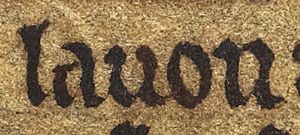
In the early 1200s, an old book called the Chronicle of Mann tells us that the wife of the Crovan ruler, Rǫgnvaldr Guðrøðarson, King of the Isles, was the sister of his half-brother's wife. This half-brother was Óláfr Guðrøðarson. The book says their shared father-in-law was a nobleman from Kintyre. This suggests he was a member of Clann Somhairle, as they were strongly linked to Kintyre. So, this father-in-law could have been Raghnall, Ruaidhrí, or even Domhnall.

Rǫgnvaldr's marriage might have happened before 1210. This marriage alliance seems to have been made to fix relations between Clann Somhairle and the Crovan family. It's possible that Ruaidhrí, as the main leader of Clann Somhairle, formally recognized Rǫgnvaldr as king. This would have made Ruaidhrí a top leader in a reunited Kingdom of the Isles. This might have happened around the time Aonghus was removed from power.
Ruaidhrí was likely one of Raghnall's sons who fought with Thomas fitz Roland, Earl of Atholl. They led a fleet of over seventy ships against the Irish in 1211 or 1212. Ruaidhrí definitely helped Thomas attack Derry and the nearby areas again in 1213 or 1214. These sea attacks might have been to help Rǫgnvaldr's interests in Ireland, as he was facing pressure then. The attacks could also mean Thomas and his Clann Somhairle allies were helping the English King in Ireland. They might have been working with the English leader, John de Grey, Bishop of Norwich. Thomas also received English land in Ireland around this time. The raids might also have been to stop Irish support for the Meic Uilleim, who were rivals of the Scottish King.
Facing the Scottish King
Forced Out of Kintyre

In 1221 or 1222, Alexander II, King of Scotland led several attacks into Argyll. Old records confirm these invasions. The king himself led the first attack in 1221, but bad weather stopped it. A very successful attack followed the next year. This campaign was the first time this region became part of Scotland. Before this, people in Argyll probably didn't see themselves as Scots.
Because of these strong royal actions, Alexander seemed to gain control of Kintyre, Knapdale, Cowal, and the islands in the Firth of Clyde. This success might explain why the royal castle of Tarbert was started. It also explains why Dumbarton became a royal town and why there was a royal officer at Dunoon. This suggests a castle was built there and Cowal was given to Walter fitz Alan II, Steward of Scotland.
It's clear that the friendly cooperation between Ruaidhrí and Thomas ended by the early 1220s. Thomas and his brother, Alan fitz Roland, Lord of Galloway, were the king's main supporters in the west. They likely played a big part in the king's actions. Thomas was certainly active in naval battles between the Hebrides and Ireland in 1221 or 1222. He defeated a fleet from the Hebrides heading to Ireland. This might have been to stop Clann Somhairle from helping Irish groups who were against English interests.

It's believed that Alexander's campaign led to a change in local rule. Ruaidhrí was replaced by Domhnall in Kintyre. For example, Ruaidhrí held lands in Kintyre in the 1200s. But a later document from Domhnall's son, Aonghus Mór, clearly states one of his church lands was "in my land which is called Kintyre." While Clann Domhnaill is well known in Kintyre later, there's no more proof of Ruaidhrí or his family there.
If Domhnall did replace Ruaidhrí, it doesn't mean he sided with the Scots against his brother. Ruaidhrí might not have wanted to submit to the Scottish King, but Domhnall might have been more willing to accept Scottish rule. After the Scottish campaign, some people in Argyll offered Alexander money and hostages for peace. Others fled, and Alexander gave their lands to his own followers.
Another person who benefited from Ruaidhrí being forced out was Donnchadh mac Dubhghaill. He seemed to become the main leader of Clann Somhairle around this time. Donnchadh might have taken advantage of the power gap in Argyll. He seemed to be given the Lordship of Argyll as a vassal (a loyal follower) of Alexander.
Ruaidhrí's expulsion might also be linked to the marriage alliance between his family and the Crovan family. Since most of Ruaidhrí's lands were on the mainland, Alexander likely saw this alliance and the united Isles as a threat to his own claims over Argyll. Fear of this strong island kingdom might have led to the Scottish invasion and Ruaidhrí's removal.
Around 1221 or 1222, the Chronicle of Mann shows that Óláfr was freed from his marriage. He then married a daughter of Fearchar mac an tSagairt, Earl of Ross. Fearchar was a rising leader closely linked to the Scottish King. Óláfr's new alliance was likely influenced by the campaign against Ruaidhrí. It was probably meant by the Scots to cause more trouble in the Isles.
According to an old story, Hákonar saga Hákonarsonar, Hákon Hákonarson, King of Norway was visited by some Islesmen. They brought him letters about their lands. These men might have visited Norway with news about the family fight between Rǫgnvaldr and Óláfr. Or, they might have been worried about Scottish attacks in the Isles after Scotland took Kintyre in 1221 or 1222.
Supporting the Meic Uilleim Rebellion
An old record says that in the 1220s, the Meic Uilleim rebelled again. It names the rebels as Giolla Easpaig, his sons, and a man named Roderick. Another old book, the Chronicle of Lanercost, seems to say Roderick was not a Meic Uilleim member.
However, the first record is older, so its information might be more accurate. If the second book is right, then this Roderick could be Ruaidhrí himself. The records say the Meic Uilleim rebellion was completely crushed. But Roderick's fate is not mentioned. If Ruaidhrí was Roderick, we don't know when he started helping the rebels. He might have supported them in the 1210s, which could explain why he lost Kintyre. But evidence against this is Ruaidhrí's attacks in Ireland in 1211 and 1213. These might have been for the Scottish King against Irish allies of the Meic Uilleim. In fact, Ruaidhrí might have only joined Alexander's enemies after he was forced out of Kintyre.
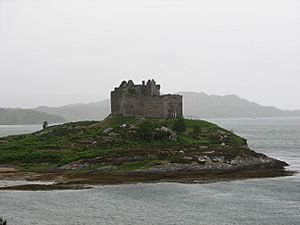
It's possible Ruaidhrí controlled lands in Garmoran and some Hebridean islands. But we don't know how or when his family got these lands. Later leaders of Clann Ruaidhrí certainly owned these lands, but there's no proof they had them before the mid-1200s.
Because the Comyn family helped put down the Meic Uilleim revolt, Walter Comyn gained the Highland lordships of Badenoch and Lochaber between 1229 and 1234. If Ruaidhrí was Roderick, and he owned Garmoran, then Garmoran's closeness to Badenoch and Lochaber could mean these areas were centers of the Meic Uilleim rebellion. Ruaidhrí would have been in a good position to hide the Meic Uilleim in Garmoran.
If Ruaidhrí owned Garmoran, then the king's gift to the Comyn family placed Walter Comyn right next to Donnchadh and Ruaidhrí. Alexander might have wanted the Comyns to put pressure on their Clann Somhairle neighbors. The fact that no troubles are recorded in the region after 1230 could mean the king's plan worked.
Óspakr-Hákon's Invasion

Meanwhile, in the Isles, the fight for kingship between Rǫgnvaldr and Óláfr continued. Rǫgnvaldr had gained support from Alan fitz Roland through marriage. But Óláfr took the kingship of the Isles in 1226 and killed Rǫgnvaldr three years later. The death of Alan fitz Roland's ally didn't stop his family's interest in the Isles. Alan fitz Roland and members of Clann Dubhghaill kept pressuring Óláfr.
News of the fighting in the Isles reached King Hákon's court in Norway in the summer of 1229. Óláfr arrived at the Norwegian court early the next year, having been forced out of the Isles by Alan fitz Roland and his allies. But Hákon had already decided what to do. The Norwegian king gave the kingship of the Isles to a Clann Dubhghaill member named Óspakr. He also gave Óspakr the royal name Hákon and put him in charge of the Norwegian fleet. This fleet was sent to bring peace back to the Isles.
Óspakr-Hákon's fleet arrived in the Isles soon after. An old story says his fleet joined forces with other Clann Dubhghaill leaders at Islay. It's unclear why Ruaidhrí and Domhnall are not mentioned in this campaign. Ruaidhrí had suffered from Alexander's attacks, and his relative, Guðrøðr Dond, played a big part in the campaign. If Ruaidhrí was part of the last Meic Uilleim rebellion, his absence from Óspakr-Hákon's campaign could mean he was satisfied with revenge against the Scots, or that he had died with the Meic Uilleim.
The old story praises Óláfr's earlier fight against Alan fitz Roland and Clann Somhairle. This suggests Hákon didn't plan to replace Óláfr with Óspakr-Hákon. Instead, Hákon seemed to want Óspakr-Hákon to rule over the large Clann Somhairle lands. This was to make sure Clann Somhairle obeyed him. Óspakr-Hákon's planned kingdom might have included Argyll, Kintyre, and the Inner Hebrides. If so, Ruaidhrí's absence from the campaign might have been because he didn't like the idea of Óspakr-Hákon being his overlord.
Domhnall's absence, on the other hand, might be because he had made a deal with the Scottish King after Ruaidhrí was forced out. He might have owed his rule in Kintyre to Alexander. If this is true, the Norwegian gathering off Islay might have been Óspakr-Hákon's attempt to show his power to Domhnall. Whatever the case, Óspakr-Hákon's fleet then entered the Firth of Clyde. They landed on Bute, where his forces successfully attacked and captured the island's fortress, which was almost certainly Rothesay Castle. The castle belonged to Walter fitz Alan II. The attack on it seems to show how worried Clann Somhairle was about the steward's growing power in the region.
Mac Somhairle
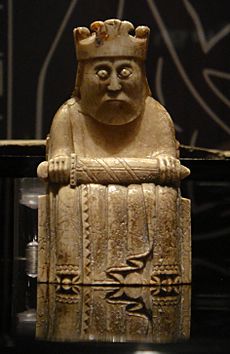
Despite the unclear information about Roderick, the last record of Ruaidhrí mentions his rule in Kintyre. It might be that the creation of the Comyn lordship, along with other lordships and the Earldom of Ross, successfully stopped Ruaidhrí if he indeed owned Garmoran.
In 1248, Ruaidhrí's son, Dubhghall, and Donnchadh's son, Eóghan, both went to Norway. They both wanted to be king of the northern Isles from Hákon. The "Southern Islands" (Hebrides and Mann) was a Norse term. It's not clear exactly what area Dubhghall and Eóghan were competing for. For example, the northern Hebridean islands of Lewis and Harris and Skye seemed to be held by the Crovan family, then led by Óláfr's son, Haraldr Óláfsson, King of the Isles. It's possible Eóghan and Dubhghall wanted the same kingship that Hákon had given to Óspakr-Hákon about ten years before.
Hákon's royal coronation was also in 1247. It's possible the Clann Somhairle leaders arrived because Norway was taking control of the Isles again. But another reason for their arrival might be the death of a "Mac Somhairle." This person, a member of Clann Somhairle, was killed while fighting an English invasion of Tír Chonaill in 1247. Just a year before, Haraldr seemed to have submitted to Henry III, King of England. It's possible Hákon had then recognized Mac Somhairle as king of the Isles to get back at Haraldr for accepting English offers. If this is true, Dubhghall and Eóghan's trip to Norway might mean they wanted to take over from their fallen relative in the Isles. While Mac Somhairle's identity is uncertain, he might be Ruaidhrí himself. Dubhghall's presence in Norway certainly suggests Ruaidhrí was dead by then.
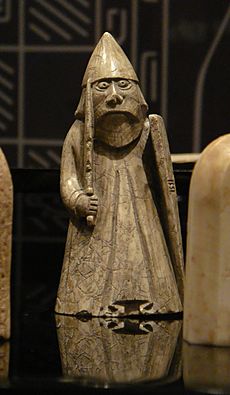
An alliance with a ruler of the Isles would have helped Henry's military actions in Ireland. It's possible that Haraldr's deal with Henry prompted Mac Somhairle to get involved against the English in Ireland. In fact, Clann Somhairle might have faced immediate problems for siding with the Norwegian King. For example, English financial records for 1248 show that Walter Bisset was told to strengthen a castle along the Scottish coast. This castle seems to be Dunaverty, on the southern coast of Kintyre. This could mean Walter Bisset's actions in Kintyre were meant to divide the Isles, separating Mann from the Hebrides. If Ruaidhrí was Mac Somhairle and died in 1247, Walter Bisset's activity at Dunaverty could mean he was taking advantage of a fortress that Ruaidhrí used to hold. Around the same year, Thomas's son, Alan, attacked the castle. This devastating attack might have ended with Walter Bisset being captured. Alan's attack on the Bissets might have been partly linked to Clann Somhairle's actions in Ireland.
Many old records mention the fall of Mac Somhairle. At the time of his death, Mac Somhairle was helping Maol Seachlainn Ó Domhnaill, King of Tír Chonaill. Maol Seachlainn was trying to stop the English from expanding when his forces were crushed by Maurice fitz Gerald, Lord of Offaly at Ballyshannon. Mac Somhairle lost his life, as did Maol Seachlainn and his main underking.
When he died, Mac Somhairle would have led a group of fighters. These were later known as gallowglasses. He might have helped the Uí Domhnaill family voluntarily, or he might have sold his fighting services to them as a mercenary. About ten years after Mac Somhairle's death, Ruaidhrí's son, Dubhghall (also called Mac Somhairle in some Irish records), fought the English in Connacht. He also made a marriage alliance with Aodh na nGall Ó Conchobhair. As part of the deal, Aodh received a tocher that included 160 gallowglass warriors led by Ruaidhrí's younger son, Ailéan. Ruaidhrí's family, Clann Ruaidhrí, were recorded as gallowglass commanders in Ireland as late as the mid-1300s.
|


